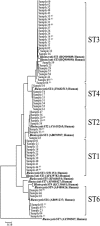A hospital qPCR-based survey of 10 gastrointestinal parasites in routine diagnostic screening, Marseille, France
- PMID: 30869032
- PMCID: PMC6518462
- DOI: 10.1017/S0950268819000165
A hospital qPCR-based survey of 10 gastrointestinal parasites in routine diagnostic screening, Marseille, France
Abstract
There is a scarcity of recent epidemiological data on intestinal parasitic infections in France. We conducted a prospective study aimed at estimating the prevalence of 10 enteric parasites in Marseille, France, using real-time polymerase chain reaction (PCR)-based diagnosis. A total of 643 faeces from 488 patients referred to the Parasitology-Mycology Laboratory of the University Hospital of Marseille over a 6 months period were included. DNA was extracted using a semi-automated method. Parasites of interest were detected using singleplex quantitative PCRs (qPCRs). For positive samples, the Blastocystis subtype was determined by sequence analysis. During the study, the overall prevalence of enteric parasites was 17%. Blastocystis sp. was the most frequent species (10.5%), followed by Dientamoeba fragilis (2.3%) and Giardia intestinalis (2.3%). The prevalence of other parasites was <1% each. The ST3 Blastocystis subtype was predominant (43.6%) and the other subtypes identified were ST1, ST2, ST4 and ST6. This is the first time that a qPCR-based diagnosis has been used to survey the prevalence of 10 enteric parasites in a French University Hospital. This study confirms that fast, specific, sensitive and simultaneous detection in a single stool sample by qPCR clearly outperforms conventional microscopy-based diagnosis. Furthermore, qPCR is particularly well suited to surveying gastroenteritis agents.
Keywords: Enteric parasites; France; microsporidia; protozoa; qPCR.
Figures


Similar articles
-
High occurrence of Blastocystis sp. subtypes 1-3 and Giardia intestinalis assemblage B among patients in Zanzibar, Tanzania.Parasit Vectors. 2016 Jun 29;9(1):370. doi: 10.1186/s13071-016-1637-8. Parasit Vectors. 2016. PMID: 27356981 Free PMC article.
-
Prevalence of intestinal parasites, with emphasis on the molecular epidemiology of Giardia duodenalis and Blastocystis sp., in the Paranaguá Bay, Brazil: a community survey.Parasit Vectors. 2018 Aug 30;11(1):490. doi: 10.1186/s13071-018-3054-7. Parasit Vectors. 2018. PMID: 30165880 Free PMC article.
-
Evaluation of the Roche LightMix Gastro parasites multiplex PCR assay detecting Giardia duodenalis, Entamoeba histolytica, cryptosporidia, Dientamoeba fragilis, and Blastocystis hominis.Clin Microbiol Infect. 2018 Dec;24(12):1333-1337. doi: 10.1016/j.cmi.2018.03.025. Epub 2018 Mar 23. Clin Microbiol Infect. 2018. PMID: 29581055
-
Intestinal parasite infections in a rural community of Rio de Janeiro (Brazil): Prevalence and genetic diversity of Blastocystis subtypes.PLoS One. 2018 Mar 9;13(3):e0193860. doi: 10.1371/journal.pone.0193860. eCollection 2018. PLoS One. 2018. PMID: 29522552 Free PMC article.
-
Epidemiology of Blastocystis sp. infection in China: a systematic review.Parasite. 2019;26:41. doi: 10.1051/parasite/2019042. Epub 2019 Jul 16. Parasite. 2019. PMID: 31309925 Free PMC article.
Cited by
-
Current status of intestinal parasitosis and microsporidiosis in industrialized countries: Results from a prospective study in France and Luxembourg.PLoS Negl Trop Dis. 2024 Dec 23;18(12):e0012752. doi: 10.1371/journal.pntd.0012752. eCollection 2024 Dec. PLoS Negl Trop Dis. 2024. PMID: 39715257 Free PMC article.
-
Prevalence of Blastocystis sp. in Morocco: Comparative assessment of three diagnostic methods and characterization of parasite forms in Jones' culture medium.Parasite. 2023;30:64. doi: 10.1051/parasite/2023065. Epub 2023 Dec 20. Parasite. 2023. PMID: 38117274 Free PMC article.
-
Comparative Assessment of In-House Real-Time PCRs Targeting Enteric Disease-Associated Microsporidia in Human Stool Samples.Pathogens. 2021 May 26;10(6):656. doi: 10.3390/pathogens10060656. Pathogens. 2021. PMID: 34073403 Free PMC article.
-
Diagnosis of Taenia solium infections based on "mail order" RNA-sequencing of single tapeworm egg isolates from stool samples.PLoS Negl Trop Dis. 2021 Dec 10;15(12):e0009787. doi: 10.1371/journal.pntd.0009787. eCollection 2021 Dec. PLoS Negl Trop Dis. 2021. PMID: 34890398 Free PMC article.
-
The Novodiag® Stool parasites assay, an innovative high-plex technique for fast detection of protozoa, helminths and microsporidia in stool samples: a retrospective and prospective study.Parasite. 2022;29:27. doi: 10.1051/parasite/2022026. Epub 2022 May 13. Parasite. 2022. PMID: 35550028 Free PMC article.
References
-
- World Health Organization (2012) Accelerating work to overcome the global impact of neglected tropical diseases: A roadmap for implementation: Executive summary. Available at http://apps.who.int/iris/handle/10665/70809?locale=en.
-
- Holtman GA et al. (2017) Dientamoeba fragilis colonization is not associated with gastrointestinal symptoms in children at primary care level. Family Practice 34, 25–29. - PubMed
Publication types
MeSH terms
LinkOut - more resources
Full Text Sources
Medical

